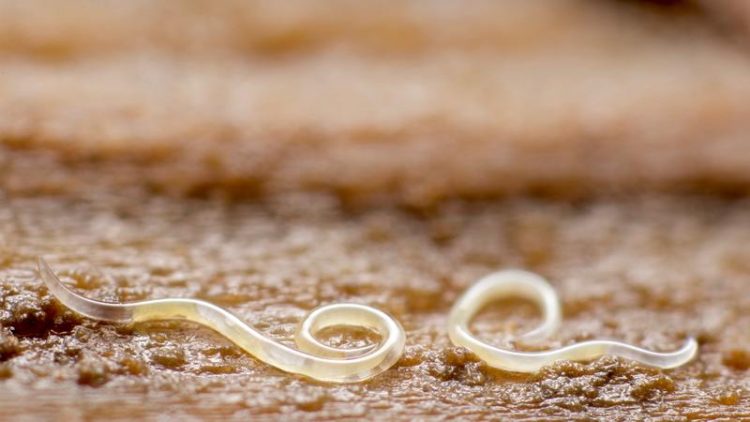Identifying the blind spots of soil biodiversity

Nematodes are very small, microscopic worms that can be found in soils almost all over the world. Andy Murray
Soils contribute to many crucial ecosystem functions and services including climate regulation, nutrient cycling, and food production. To support their conservation, it is essential to know which macroecological patterns are related to the functioning of soil organisms – only then can we understand the effects of global change drivers.
Such analyses need to represent the diversity of environmental conditions that can be found worldwide. Despite the mounting number of soil ecology studies, major gaps still exist in our understanding of soil biodiversity.
To identify these environmental gaps, an international team of researchers led by the German Centre for Integrative Biodiversity Research (iDiv) performed an analysis of soil macroecological studies and over 17,000 sampling sites across the globe.
“This effort involved researchers from all continents and we found not only large gaps in important spatial, environmental, and taxonomic representation, but also an almost complete absence of temporally explicit data,” said lead author Dr Carlos Guerra, researcher at iDiv and MLU.
Given the many legal and logistic limitations related to soil macroecology, researchers often prefer to expand their number of sites rather than seeing what is happening over time.
“This prevents scientists from properly assessing the effects of climate change on soil organisms and functions, but also stakeholders from taking appropriate management actions to preserve and maintain important ecosystem services, such as food and water security, for which soils are the main provider.”
Lack of data for most diverse places on Earth
In contrast to other ecosystems like aboveground terrestrial, one major issue with respect to soil biodiversity is that the data does not represent all ecosystems. Gaps exist, for example, for most tropical systems: soil biodiversity and function data is scarce or even non-existent in tropical and subtropical regions, which are among the most megadiverse places on Earth.
The researcher found that temperate biomes (especially broadleaved mixed forests and Mediterranean) contain more sampling sites than tundra, flooded grasslands and savannas, mangroves, and most of the tropical biomes. “This likely reflects differences in funding availability and research focus and infrastructures across countries,” said Carlos Guerra.
At the same time, for many of the best-represented regions across the globe, there is rarely a complete picture of the hidden life below the surface. Instead, records are often dominated by one or two taxa such as bacteria and fungi.
“We all heavily depend on the biodiversity under our feet – it is time to better understand this underexplored part of biodiversity,” said Professor Nico Eisenhauer, head of the Experimental Interaction Ecology research group at iDiv and UL.
Understanding what is happening – and why
In a changing world where land-use intensity, desertification, and rapid climate change are forecast to increase, it is important to understand if and to what extent biodiversity changes are happening in the soil.
This is particularly relevant to assess the links between changes in biodiversity and ecosystem function: for example, whether changes in biodiversity occur because of changes in function, coupled with them, or despite them.
The researchers highlight the need for action to facilitate a global soil monitoring system that overcomes the current limitations. “This study is a milestone revealing the status quo and informing future soil biodiversity monitoring,” said Nico Eisenhauer.
“Now, the next steps require two complementary pathways: making data available and standardized for further research and globally standardized sampling. Something that we are already working to put in place,” said Carlos Guerra Ultimately, this could help track the fulfilment of global or national biodiversity targets, and support policy and decision-making.
This research was supported by the DFG – Deutsche Forschungsgemeinschaft (FZT-118).
Dr. Carlos Guerra, carlos.guerra@idiv.de
Carlos A. Guerra, Anna Heintz-Buschart, Johannes Sikorski, Antonis Chatzinotas, Nathaly Guerrero-Ramírez, Simone Cesarz, Léa Beaumelle, Matthias C. Rillig, Fernando T. Maestre, Manuel Delgado-Baquerizo, François Buscot, Jörg Overmann, Guillaume Patoine, Helen R. P. Phillips, Marten Winter, Tesfaye Wubet, Kirsten Küsel, Richard D. Bardgett, Erin K. Cameron, Don Cowan, Tine Grebenc, César Marín, Alberto Orgiazzi, Brajesh K. Singh, Diana H. Wall, Nico Eisenhauer (2020). Blind spots in global soil biodiversity and ecosystem function research. Nature Communications. DOI: 10.1038/s41467-020-17688-2
Media Contact
More Information:
http://www.idiv.de/All latest news from the category: Life Sciences and Chemistry
Articles and reports from the Life Sciences and chemistry area deal with applied and basic research into modern biology, chemistry and human medicine.
Valuable information can be found on a range of life sciences fields including bacteriology, biochemistry, bionics, bioinformatics, biophysics, biotechnology, genetics, geobotany, human biology, marine biology, microbiology, molecular biology, cellular biology, zoology, bioinorganic chemistry, microchemistry and environmental chemistry.
Newest articles

Pinpointing hydrogen isotopes in titanium hydride nanofilms
Although it is the smallest and lightest atom, hydrogen can have a big impact by infiltrating other materials and affecting their properties, such as superconductivity and metal-insulator-transitions. Now, researchers from…

A new way of entangling light and sound
For a wide variety of emerging quantum technologies, such as secure quantum communications and quantum computing, quantum entanglement is a prerequisite. Scientists at the Max-Planck-Institute for the Science of Light…

Telescope for NASA’s Roman Mission complete, delivered to Goddard
NASA’s Nancy Grace Roman Space Telescope is one giant step closer to unlocking the mysteries of the universe. The mission has now received its final major delivery: the Optical Telescope…



